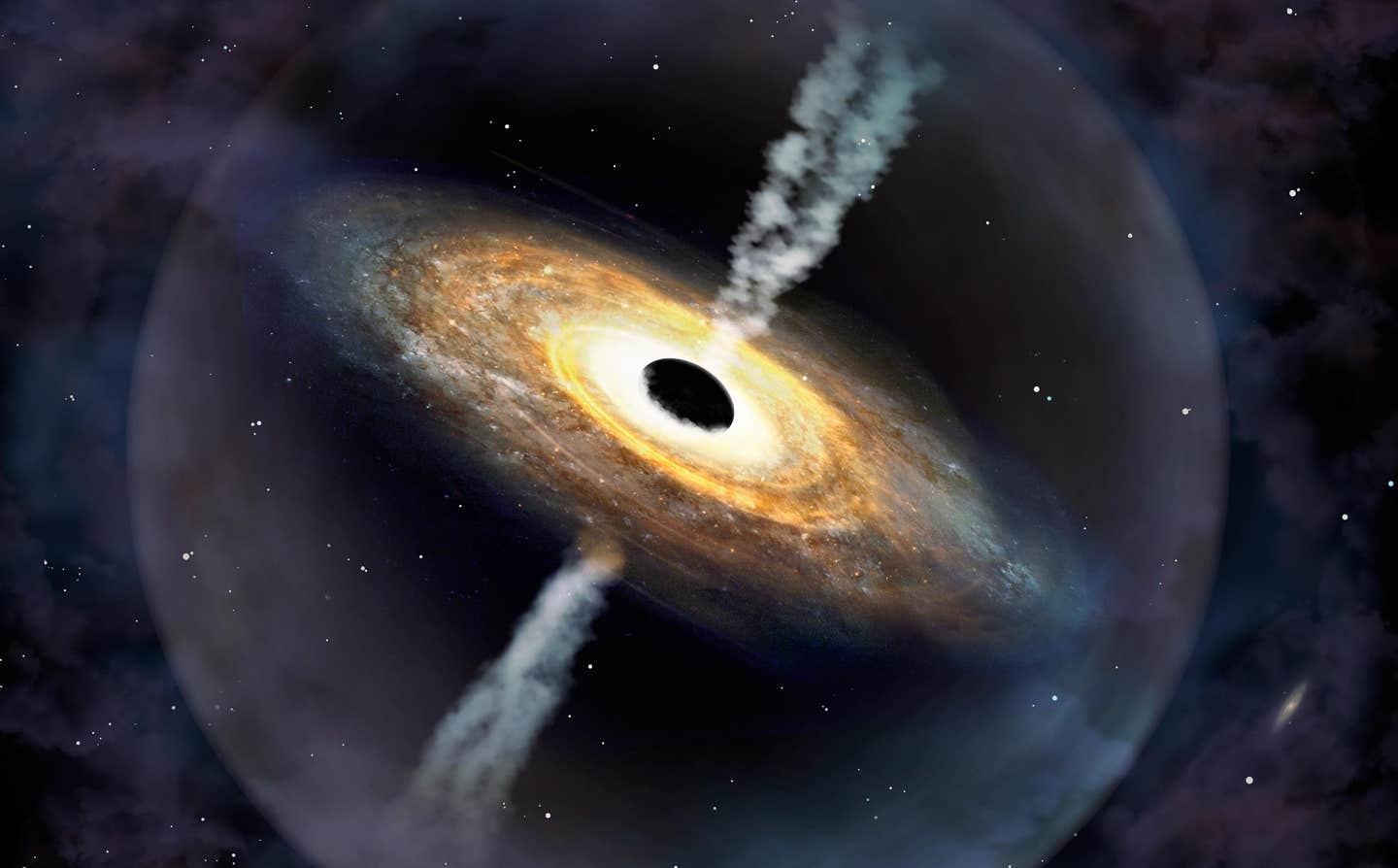There are 40 billion billions of black holes in the universe
How many black holes are out there in the Universe? This is one of the most relevant and pressing questions in modern cosmology.

[Jan 18, 2022: Scuola Internationale Superiore di Studi Avanzati]
An artist’s impression of the formation of quasar Pōniuā`ena, starting with a seed black hole, 100 million years after the Big Bang. (Credit: International Gemini Observatory/NOIRLab/NSF/AURA/P. Marenfeld)
How many black holes are out there in the Universe?
This is one of the most relevant and pressing questions in modern astrophysics and cosmology. The intriguing issue has recently been addressed by the SISSA Ph.D. student Alex Sicilia, supervised by Prof. Andrea Lapi and Dr. Lumen Boco, together with other collaborators from SISSA and from other national and international institutions. In a first paper of a series just published in The Astrophysical Journal, the authors have investigated the demographics of stellar mass black holes, which are black holes with masses between a few to some hundred solar masses, that originated at the end of the life of massive stars.
According to the new research, a remarkable amount around 1% of the overall ordinary (baryonic) matter of the Universe is locked up in stellar mass black holes. Astonishingly, the researchers have found that the number of black holes within the observable Universe (a sphere of diameter around 90 billions light years) at present time is about 40 trillions, 40 billion billions (i.e., about 40 x 1018, i.e. 4 followed by 19 zeros!).
A new method to calculate the number of black holes
As the authors of the research explain: “This important result has been obtained thanks to an original approach which combines the state-of-the-art stellar and binary evolution code SEVN developed by SISSA researcher Dr. Mario Spera to empirical prescriptions for relevant physical properties of galaxies, especially the rate of star formation, the amount of stellar mass and the metallicity of the interstellar medium (which are all important elements to define the number and the masses of stellar black holes). Exploiting these crucial ingredients in a self-consistent approach, thanks to their new computation approach, the researchers have then derived the number of stellar black holes and their mass distribution across the whole history of the Universe.
Alex Sicilia, first author of the study, comments: “The innovative character of this work is in the coupling of a detailed model of stellar and binary evolution with advanced recipes for star formation and metal enrichment in individual galaxies. This is one of the first, and one of the most robust, ab initio computation of the stellar black hole mass function across cosmic history.”
Related Stories
What’s the origin of most massive stellar black holes?
The estimate of the number of black holes in the observable Universe is not the only issue investigated by the scientists in this piece of research. In collaboration with Dr. Ugo Di Carlo and Prof. Michela Mapelli from University of Padova, they have also explored the various formation channels for black holes of different masses, like isolated stars, binary systems and stellar clusters.
According to their work, the most massive stellar black holes originate mainly from dynamical events in stellar clusters. Specifically, the researchers have shown that such events are required to explain the mass function of coalescing black holes as estimated from gravitational wave observations by the LIGO/Virgo collaboration.
Lumen Boco, co-author of the paper, comments: “Our work provides a robust theory for the generation of light seeds for (super)massive black holes at high redshift, and can constitute a starting point to investigate the origin of ‘heavy seeds’, that we will pursue in a forthcoming paper.
A multidisciplinary work carried out in the context of “BiD4BESt - Big Data Application for Black Hole Evolution Studies”
Prof. Andrea Lapi, Sicilia’s supervisor and coordinator of the Ph.D. in Astrophysics and Cosmology at SISSA, adds: “This research is really multidisciplinary, covering aspects of, and requiring expertise in stellar astrophysics, galaxy formation and evolution, gravitational wave and multi-messenger astrophysics; as such it needs collaborative efforts from various members of the SISSA Astrophysics and Cosmology group, and a strong networking with external collaborators.”
Alex Sicilia’s work occurs in the context of a prestigious Innovative Training Network Project “BiD4BESt - Big Data Application for Black Hole Evolution Studies” co-PIed by Prof. Andrea Lapi from SISSA (H2020-MSCAITN-2019 Project 860744), that has been funded by the European Union with about 3.5 million Euros overall; it involves several academic and industrial partners, to provide Ph.D. training to 13 early stage researchers in the area of black hole formation and evolution, by exploiting advanced data science techniques.
Note: Materials provided above by Scuola Internationale Superiore di Studi Avanzati. Content may be edited for style and length.
Like these kind of feel good stories? Get the Brighter Side of News' newsletter.
Tags: #New_Discovery, #Astronomy, #Universe, #Black_Holes, #Research, #Science, #Astrophysics, #The_Brighter_Side_of_News
Joseph Shavit
Head Science News Writer | Communicating Innovation & Discovery
Based in Los Angeles, Joseph Shavit is an accomplished science journalist, head science news writer and co-founder at The Brighter Side of News, where he translates cutting-edge discoveries into compelling stories for a broad audience. With a strong background spanning science, business, product management, media leadership, and entrepreneurship, Joseph brings a unique perspective to science communication. His expertise allows him to uncover the intersection of technological advancements and market potential, shedding light on how groundbreaking research evolves into transformative products and industries.



